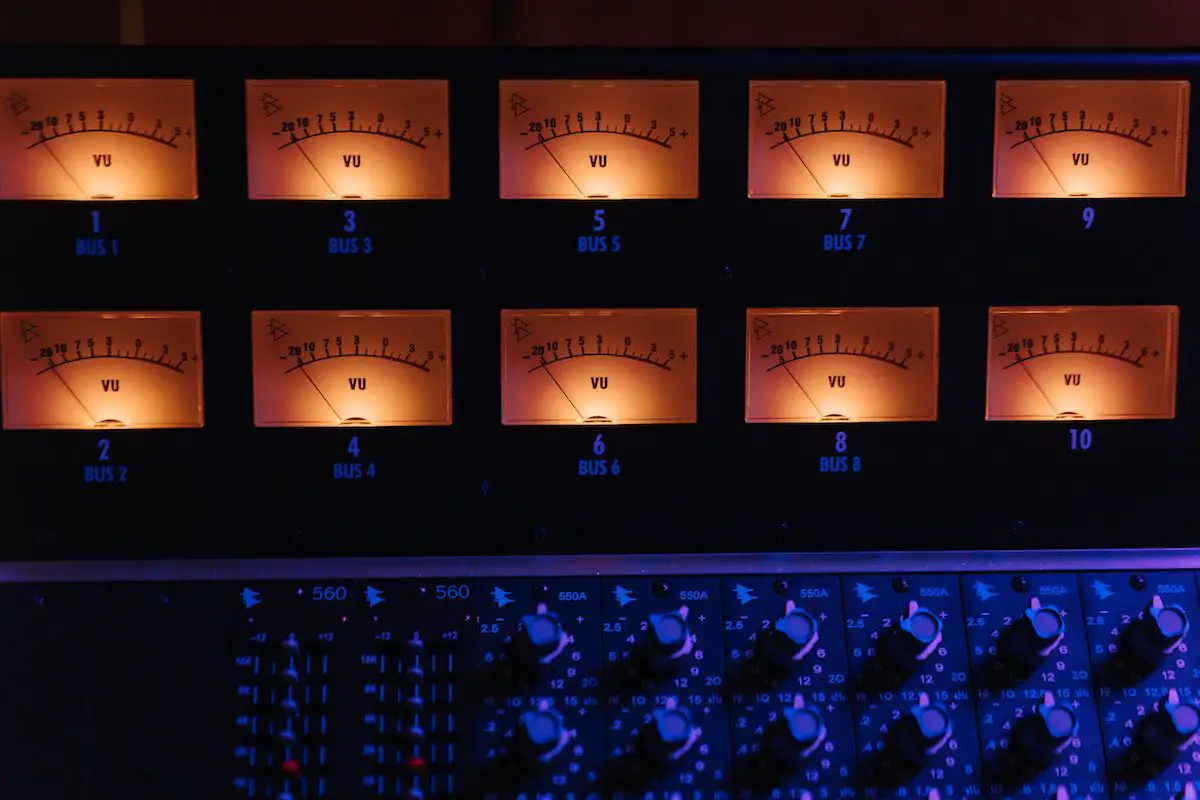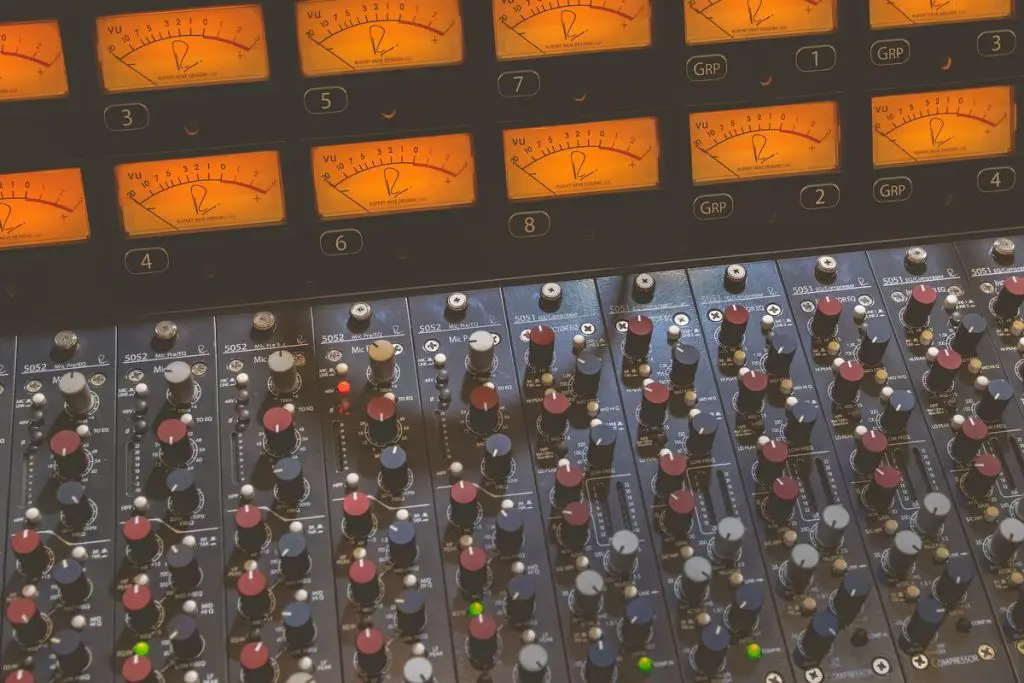Ever been stuck tweaking your mix, unsure if the volume is just right? Enter the VU meter, your secret weapon to achieving perfect volume balance in your tracks. It’s more than just a fancy gadget—it’s a game-changer in the audio mixing world, and it could be the missing link in your music production process. So, what exactly is a VU meter? Let’s dive in.
What is a VU Meter? A VU meter, or Volume Unit meter, is a crucial tool in music production, primarily used for measuring the volume and loudness of a track. It’s unique because it’s based on electrical voltage, giving a more accurate representation of how we humans perceive volume compared to digital meters.
What is a VU meter in audio mixing?
A VU meter (Volume Unit meter) is a tool that measures the volume and loudness of a track in the world of audio mixing. In the simplest terms, the VU meter is the barometer for your music’s ‘loudness weather’.

Here’s a cool fact: a VU meter works based on electrical voltage. That gives it an ‘analog edge’, you could say, over digital meters. Just like vinyl has a certain charm, the VU meter, with its voltage-based operations, brings a touch of old-school cool to modern music production.
Now, you might be thinking, “Why should I care about voltage?” Well, the trick is that it ties in with how we humans perceive volume. A VU meter, because of its voltage-based measurement, aligns more accurately with our perception of loudness than its digital counterparts. Basically, it’s designed to ‘hear’ the way we do, pretty neat, huh?
AKAI Professional MPK Mini MK3

AKAI Professional MPK Mini MK3
Why does a VU meter matter in music production?
If you’re new to audio engineering, you might have come across the term ‘dBFS.’ It stands for decibels relative to full scale, which is a unit of measurement for audio levels in the digital domain. But here’s the clincher: the average level of your track should hover around -18 dBFS, and the VU meter is your best buddy in hitting that sweet spot.
In music, volume can make or break the energy and emotion of your track.
Volume isn’t just about keeping your neighbors from banging on your walls. In music, volume can make or break the energy and emotion of your track. The VU meter can guide you to create dynamic contrast between different parts of a song, much like how a film director uses quiet and loud scenes for dramatic effect. Think of your favorite epic movie scene – yeah, that’s the power of volume dynamics!
What is the ‘sweet spot’ when using a VU meter?
Imagine you’re a chef. You add a pinch of this and a dash of that, tasting along the way. Why? To make sure it’s all balanced and delicious. The same principle applies to audio mixing. You don’t want your track to be too loud or too soft—it has to be just right. And in the audio world, ‘just right’ is around -18 dBFS on your VU meter. The sweet spot is not just a number, but the perfect blend of all elements in your mix.
But why -18 dBFS, you might ask? It’s because this level keeps your audio healthy—it won’t get distorted or too quiet. Consider it as the ‘Goldilocks zone’ for your mix, like that perfect middle ground on a seesaw, where both sides are balanced, and you’re not flying off into the sandpit.
Remember, your ears are the ultimate judge, so if something sounds off, it probably is. The VU meter is there to guide you, but it’s not the be-all and end-all.
Should the volume of different parts of a song vary when using a VU meter?
Okay, so you’ve got your mix dialed in at -18 dBFS. Sweet! But now you’re probably wondering, “Does that mean the whole song stays at the same volume?” Well, my friend, it’s time to delve into the dynamics.
Just like a rollercoaster ride, a good song has ups and downs. In fact, the chorus of your track should be slightly louder than the verse by about 2-4 dB. It’s the ‘WOW’ factor that makes your listeners sit up and take notice. But remember, dynamics aren’t just about volume—it’s about the energy and emotion of your song.
That being said, there’s no hard and fast rule here. If your verse is more energetic than your chorus, then by all means, make it louder. You’re the artist, and it’s your call. Just like Quentin Tarantino might flip the script and do something unconventional in his movies, you can do the same with your music.
| Do’s | Don’ts |
|---|---|
| Use the VU meter as a guide to achieve balanced volume in your mix | Don’t rely on it solely—trust your ears |
| Dial in your mix at around -18 dBFS | Don’t obsess over hitting the exact number |
| Make the chorus slightly louder than the verse | Don’t stick to this rule rigidly—the song’s energy should dictate the volume |
How can a VU meter improve your mixing?
Imagine you’ve got this killer mix, but it just doesn’t quite measure up to your favorite reference tracks. Don’t fret, my friend! The VU meter can be your secret weapon to match the volume of those pro tracks. By analyzing their levels and comparing them to your own mix, you can make adjustments to achieve that sweet, polished sound.

Now, picture this: you’re in the studio, surrounded by vintage gear, and you’re working your magic on an analog mixing console. Ah, the warm tones and juicy goodness! But how do you find that sweet spot where everything sounds just right? Well, my friend, the VU meter can be your trusty guide. By using the VU meter, you can find the optimal level for analog-based mixing tools and truly unleash their potential.
Advantages and disadvantages of using a VU meter
Now, let’s explore the advantages and disadvantages of using a VU meter in audio mixing. Understanding both sides of the coin will help you make informed decisions about incorporating this tool into your workflow.
Advantages of using a VU meter
- Accurate Perception: The VU meter provides a more accurate representation of volume as perceived by human ears, allowing you to achieve a balanced mix that resonates with listeners.
- Analog Feel: With its voltage-based measurement, the VU meter brings a touch of warmth and nostalgia to your digital workflow, emulating the characteristics of analog gear.
- Dynamic Control: By guiding you to maintain an average level of around -18 dBFS, the VU meter helps you create dynamic contrasts between different parts of a song, adding excitement and impact.
Disadvantages of using a VU meter
- Digital Limitations: While the VU meter offers benefits, it might not be as precise as digital peak meters in detecting quick transients or extremely low-level details.
- Contextual Variations: The optimal volume for a mix depends on various factors, including the genre, song structure, and artistic intent. Relying solely on the VU meter’s readings may overlook the contextual nuances.
- Compatibility Challenges: Some modern plugins and digital audio workstations (DAWs) may not have built-in VU meter support, requiring additional tools or plugins to incorporate this metering method into your workflow.
Frequently Asked Questions (FAQ)
Here are some common questions that arise when it comes to understanding VU meters and their role in audio mixing.
Can I rely solely on a VU meter for setting volume levels in my mix?
While a VU meter is a valuable tool for achieving balanced volume, it’s important to remember that it is just one piece of the puzzle. Your ears should always be the final judge. Use the VU meter as a guide, but trust your instincts and critical listening skills to make the final volume decisions.
Can I use a VU meter for digital mixing, or is it only suitable for analog workflows?
Absolutely! The VU meter can be used in both digital and analog mixing workflows. In the digital realm, you can find VU meter plugins or built-in metering options in your digital audio workstation (DAW). It’s a versatile tool that transcends the boundaries of technology, providing you with valuable volume insights regardless of your workflow.
How can I incorporate a VU meter into my digital audio workstation (DAW) if it doesn’t have built-in metering?
If your DAW doesn’t have a built-in VU meter, don’t worry! There are various VU meter plugins available that can be seamlessly integrated into your workflow. These plugins can serve as an additional metering tool, allowing you to leverage the benefits of a VU meter within your preferred DAW.
Conclusion
Well, we’ve reached the end of our sonic journey through the world of VU meters. We’ve learned how this humble tool, based on electrical voltage, can revolutionize your audio mixing game. It’s the Yin to your Yang, the Salt to your Pepper, and the treble to your bass. So go forth, my fellow music producers, and embrace the power of the VU meter. Remember, when it comes to volume, finding the sweet spot is the key to harmony in your mix.
Key Takeaways
This article covered the ins and outs of VU meters in audio mixing. Here are some key takeaways:
- The VU meter is a tool used to measure volume and loudness in audio mixing, providing a more accurate representation of human perception compared to digital meters.
- The average level of a track should be around -18 dBFS, which can be achieved using the VU meter as a guide.
- The VU meter can be used to match the volume of reference tracks, find the sweet spot for analog-based mixing tools, and create dynamic contrast in your mixes.
- Trust your ears alongside the VU meter, as they are the ultimate judge of your mix’s quality.
Did I cover everything you wanted to know? Let me know in the comments section below. I read and reply to every comment. If you found this article helpful, share it with a friend and check out my full blog for more tips and tricks on audio production. Thanks for reading, and may your mixes be balanced and your beats be bumpin’!















